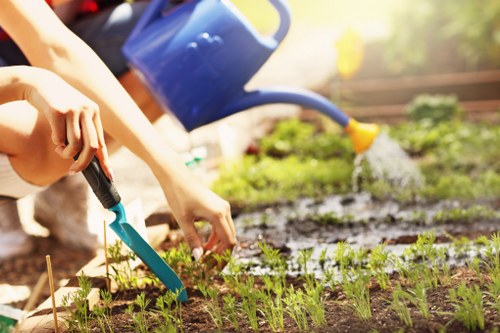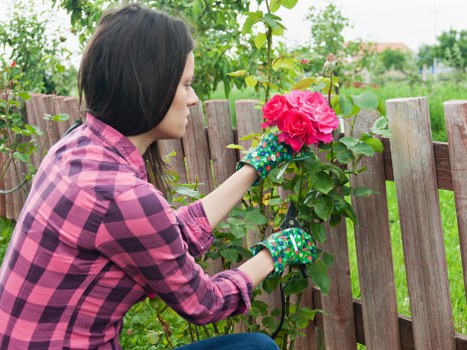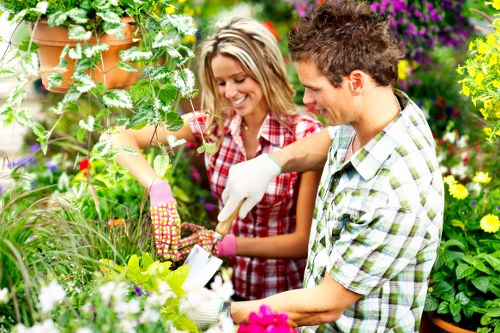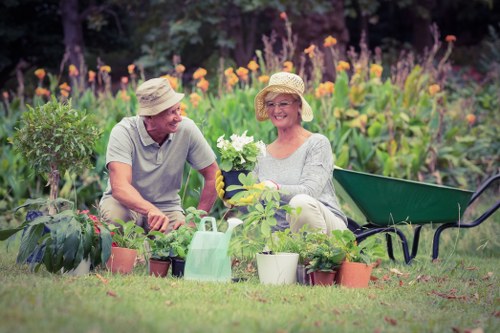Comprehensive Guide to Garden Fencing in Garden Fence Installation

Garden fencing serves as more than just a boundary marker for your outdoor space. It enhances the aesthetic appeal, provides privacy, and offers security for your plants and loved ones. Whether you’re looking to install a new fence or replace an old one, understanding the various aspects of garden fencing is essential for making an informed decision.
When planning your garden fence installation, consider the purpose of the fence. Are you aiming to keep pets and children safe, deter unwanted wildlife, or simply add a decorative element to your garden? Each goal may require different materials and designs.
There are numerous types of garden fencing available, each with its unique benefits and styles. From traditional wooden fences to modern metal options, the variety ensures that every garden has the perfect fence to complement its landscape.
Choosing the Right Material for Your Garden Fence

The material you choose for your garden fencing plays a significant role in the overall look and functionality. Here are some popular options:
- Wood: Classic and versatile, wooden fences can be customized with various stains and paints.
- Metal: Offers durability and security, available in styles like wrought iron or aluminum.
- Vinyl: Low maintenance and resistant to weather elements, vinyl fences come in various colors.
- Composite: Made from a mix of wood fibers and plastic, composite fences are eco-friendly and durable.

**Wooden fences** are favored for their natural appearance and ability to blend seamlessly into garden settings. They can be tailored to different heights and designs, making them suitable for both privacy and decorative purposes.
**Metal fences**, on the other hand, offer a more secure option. They are less prone to damage and can provide a more robust barrier against intruders. Styles like wrought iron add an elegant touch to any garden.
**Vinyl fences** are becoming increasingly popular due to their ease of maintenance. Unlike wood, they do not require regular painting or staining and are resistant to rot and pests.
Installation Process for Garden Fences

Proper installation is crucial for the longevity and effectiveness of your garden fence. Here’s a step-by-step overview:
- Planning and Measurement: Determine the area to be fenced and measure the perimeter accurately.
- Permits and Regulations: Check local regulations and obtain necessary permits before starting the installation.
- Material Selection: Choose the appropriate fencing material based on your needs and preferences.
- Preparing the Site: Clear the area of any debris and ensure the ground is level.
- Setting Posts: Install fence posts securely, ensuring they are level and spaced correctly.
- Installing Panels or Rails: Attach the fencing panels or rails to the posts, ensuring stability.
- Finishing Touches: Add any decorative elements or gates as desired.

**Setting fence posts** is a critical step that requires precision. Posts should be buried at least one-third of their total length in the ground to ensure stability. Use concrete to secure the posts and prevent shifting over time.
**Attaching fence panels** involves aligning them correctly and securing them firmly to the posts. This ensures that the fence remains straight and free from gaps that could compromise its effectiveness.
**Adding decorative elements** such as lattice work or ornamental designs can enhance the visual appeal of your garden fence. These elements can be customized to match the overall theme of your garden.
Benefits of Quality Garden Fencing
Investing in a quality garden fence offers numerous advantages:
- Privacy: A solid fence provides a secluded space, allowing you to enjoy your garden without prying eyes.
- Security: Fencing deters intruders and keeps pets and children safe within the designated area.
- Aesthetic Appeal: A well-designed fence can enhance the beauty of your garden, adding to its overall charm.
- Property Value: Quality fencing can increase the value of your property, making it a worthwhile investment.

**Privacy fencing** is ideal for those seeking a private retreat in their backyard. Taller fences with minimal gaps can effectively block the view from neighbors and passersby.
**Security fencing** provides an additional layer of protection for your property. Materials like metal and sturdy wood are preferred for their durability and strength.
**Decorative fencing** adds character to your garden. Intricate designs and unique styles can make your fence a focal point of your outdoor space.
Maintenance Tips for Garden Fences
Proper maintenance ensures that your garden fence remains functional and visually appealing for years to come. Here are some maintenance tips:
- Regular Cleaning: Remove dirt, debris, and mildew by washing your fence with appropriate cleaning solutions.
- Inspection: Regularly inspect your fence for any signs of damage or wear and address issues promptly.
- Painting and Staining: For wooden fences, apply paint or stain to protect against the elements and prevent decay.
- Repairing: Fix any broken or loose panels, posts, or rails to maintain the fence’s integrity.

**Wooden fences** require periodic painting or staining to maintain their appearance and protect them from moisture and pests.
**Metal fences** should be checked for rust and corrosion. Applying a protective coating can prevent deterioration.
**Vinyl fences** are low maintenance but should still be cleaned regularly to remove any dirt or stains.
Design Ideas for Garden Fencing
Creative design ideas can transform your garden fence into a stunning feature:
- Lattice Panels: Add a decorative touch while allowing climbing plants to flourish.
- Ornamental Post Caps: Enhance the look of your fence posts with unique caps.
- Color Coordination: Paint your fence in colors that complement your garden’s palette.
- Integrated Lighting: Incorporate lighting into your fence design for both functionality and ambiance.

**Lattice panels** not only add a decorative element but also provide support for vines and flowering plants, integrating nature with your fence.
**Ornamental post caps** come in various shapes and designs, adding a personalized touch to your fencing.
**Color coordination** ensures that your fence complements the existing colors in your garden, creating a harmonious look.
Eco-Friendly Fencing Options
For environmentally conscious gardeners, there are several eco-friendly fencing options:
- Recycled Materials: Fences made from recycled plastic or metal reduce waste and promote sustainability.
- Bamboo Fencing: A renewable resource, bamboo offers a natural and sustainable fencing solution.
- Composite Fencing: Combining wood fibers and plastic, composite fences are durable and eco-friendly.

**Recycled plastic fences** are durable and resistant to weather, making them a sustainable choice that requires minimal maintenance.
**Bamboo fences** offer a unique aesthetic and are highly renewable, supporting eco-friendly gardening practices.
**Composite fences** provide the look of wood without the associated maintenance, making them both practical and environmentally responsible.
Cost Considerations for Garden Fence Installation
Understanding the costs involved in garden fence installation helps in budgeting and making informed decisions:
- Material Costs: Different materials come at varying prices. Wood is generally affordable, while metal and composite materials may be pricier.
- Labor Costs: Professional installation ensures quality but adds to the overall expense.
- Maintenance Costs: Consider the long-term maintenance required for each fencing material.
- Permits and Regulations: Some areas may require permits for fence installation, which can incur additional costs.

**Wooden fences** are cost-effective initially but may require regular maintenance. **Metal fences** have a higher upfront cost but offer longevity and low maintenance.
**Vinyl fences** balance cost and maintenance, providing a durable option that requires minimal upkeep.
**Composite fences** are an investment that pays off through durability and eco-friendliness, though the initial cost is higher.
Hiring a Professional vs. DIY Installation
Deciding whether to hire a professional or undertake a DIY fence installation depends on various factors:
- Skill Level: DIY installation requires certain skills and tools. If you lack experience, hiring a professional is advisable.
- Time Commitment: Professional installers can complete the job faster, whereas DIY projects may take longer.
- Cost: While hiring professionals incurs labor costs, DIY can save money if you have the necessary skills and tools.
- Quality: Professionals ensure the fence is installed correctly, ensuring its longevity and effectiveness.

**Professional installation** guarantees that your fence is built to last, adhering to all local codes and standards. It also ensures precise measurements and alignment.
**DIY installation** can be rewarding and cost-effective if you have the requisite knowledge and time. It allows for personalized customization and flexibility in design.
Choosing between professional and DIY installation depends on your personal preferences, budget, and the complexity of the project.
Enhancing Your Garden Fence with Accessories
Accessorizing your garden fence can enhance its functionality and appearance:
- Gates: Essential for access, gates come in various styles to match your fence.
- Locks and Latches: Improve the security of your fence with reliable locks and latches.
- Decorative Elements: Add finials, finial caps, or decorative panels to personalize your fence.
- Climbing Plants: Integrate climbing plants like ivy or roses to add greenery and color.

**Gates** provide practical access points and can be designed to complement the overall style of your fence. Sliding gates, swinging gates, and decorative gates offer various functional and aesthetic options.
**Locks and latches** enhance the security aspect of your fence, ensuring that it serves its intended purpose effectively.
**Decorative elements** such as finials or custom panels add a unique touch, making your fence stand out as a feature of your garden.
Sustainable Practices in Garden Fence Installation
Implementing sustainable practices during fence installation contributes to environmental conservation:
- Using Recycled Materials: Opt for fences made from recycled or sustainably sourced materials.
- Proper Disposal: Dispose of old fencing materials responsibly to minimize environmental impact.
- Water Conservation: Plan your fence layout to promote water-efficient gardening practices.
- Energy Efficiency: Incorporate solar lighting or other energy-efficient accessories.

**Recycled material fences** reduce the demand for new resources and help in minimizing waste. Choosing locally sourced materials can further decrease your environmental footprint.
**Proper disposal** of existing fencing during replacement ensures that materials do not end up in landfills, promoting recycling and reuse.
**Energy-efficient lighting** integrated into your fence design provides illumination while conserving energy, adding both functionality and sustainability.
Final Thoughts on Garden Fencing
Garden fencing plays a pivotal role in shaping the functionality and aesthetics of your outdoor space. By carefully selecting the right materials, design, and installation method, you can create a fence that not only serves its purpose but also enhances the beauty of your garden.
Whether you prioritize privacy, security, or aesthetic appeal, there is a garden fencing solution tailored to your needs. Regular maintenance and thoughtful design choices ensure that your fence remains a valuable and attractive feature of your property for years to come.
Ready to transform your garden with the perfect fence? Contact us today to discuss your garden fence installation needs and discover the best options for your outdoor space.